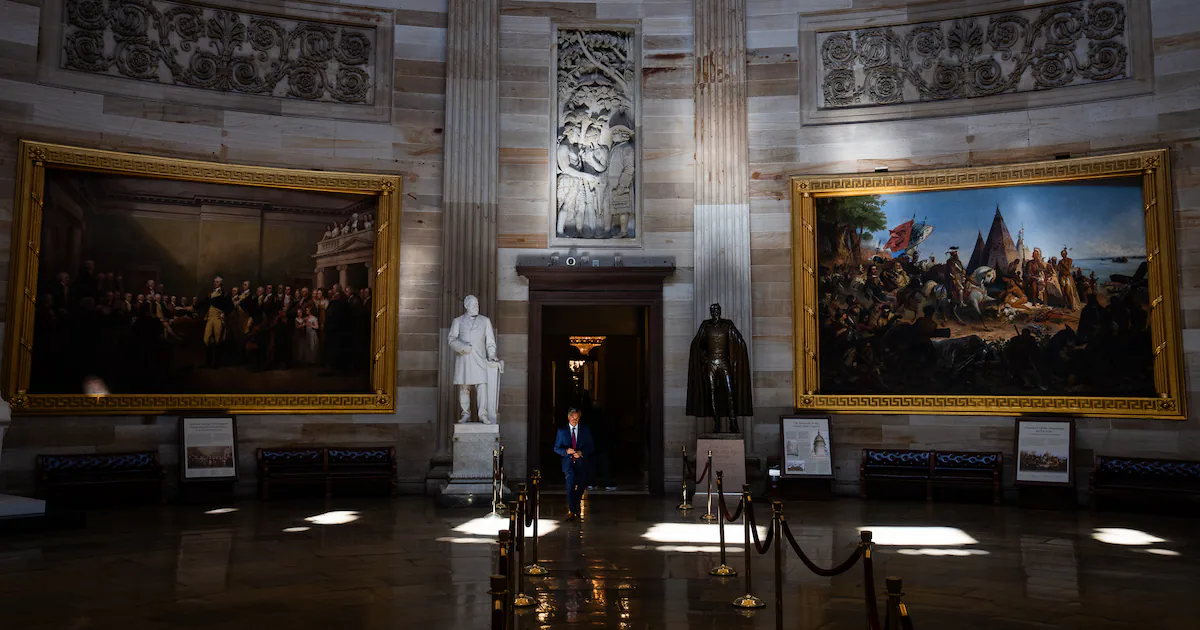
The federal government officially shut down Wednesday after the Senate didn’t pass a measure to extend funding at current levels for seven weeks. While it’s too early to know how long this shutdown will last, they always end up costing extra taxpayer money, and the price tag for the most recent one – during President Donald Trump’s first term – was about $11 billion.
That was also the longest shutdown, stretching for 34 days from December 2018 to January 2019. This time, Democrats and Republicans are deadlocked over extending health care subsidies that otherwise will expire at the end of the year – with neither side appearing willing to budge.
Vice President JD Vance predicted Wednesday that it would not be “that long” of a shutdown.
“I think you already saw some evidence that moderate Democrats are cracking a little, but they understand the fundamental illogic of this,” Vance told reporters at the White House.
Democrats, however, have held firm and rejected a stopgap funding measure from the House GOP on Wednesday, with the same vote breakdown – 55 to 45 – as Tuesday night.
Shutdowns in recent history can provide a sense of how much this impasse could cost the United States. Since the 1980s, there have been four shutdowns that have lasted five days or more, racking up extra administrative costs, forcing federal workers to penny-pinch and preventing small businesses from obtaining loans, among other costs.
– – –
Government shutdowns ultimately cost Americans money
Furloughed federal employees cannot work during a shutdown, but once a deal is reached, they must be paid back for the time they would have been working. That means the government and American taxpayers still must pay for thousands of days of lost work. In the last decade, for example, over 56,000 years of work productivity were lost during three government shutdowns that spanned more than 50 days cumulatively, according to a Senate report from 2019.
The administrative cost of furloughs and shuttering offices, as well as late fees on interest payments, further harms American coffers. Businesses may also face difficulties getting approved for federal permits, which have previously affected investment and hiring decisions, according to the Congressional Budget Office.
Beyond the financial cost, the Senate reported that a variety of government functions are suspended during shutdowns, including roughly 60,000 Justice Department hearings for non-detained migrants in 2019. Government efforts to screen for the safety of thousands of goods are also limited, including ensuring that children’s products don’t contain excessive lead.
According to the Congressional Budget Office, about 750,000 employees could be furloughed during this shutdown – totaling about $400 million in compensation per day. That number could vary, depending on how many employees an agency furloughs over the duration of the shutdown.
– – –
Trump has threatened mass layoffs this time
Trump administration officials have threatened to use this shutdown as an opportunity to institute mass firings, instead of furloughs, to expand their efforts to drastically cut the federal workforce. Under White House budget director Russell Vought, the Office of Management and Budget advised agencies to “consider notifying their employees of a reduction in force” if their work was no longer funded during the shutdown or was “not consistent with the President’s priorities.”
Trump discussed the potential layoffs Tuesday at the White House.
“We can do things during the shutdown that are irreversible, that are bad for [Democrats], and irreversible by them, like cutting vast numbers of people out, cutting things that they like, cutting programs that they like,” Trump said.
According to the Congressional Budget Office, firing federal employees would reduce the daily cost of compensation for furloughed workers – though their productivity would be lost permanently even after a shutdown ends.
White House press secretary Karoline Leavitt said Wednesday that she expected layoffs to begin this week.
[Senior government officials privately warn against firings during shutdown]
– – –
Many government agencies can’t complete routine tasks
As in previous years, some agencies are almost completely shuttered, including the Education, Commerce, Labor and State departments. More than 90 percent of the National Labor Relations Board and the Equal Employment Opportunity Commission is being placed on furlough, as is more than 80 percent of NASA – representing 15,000 people – planning documents show.
This means administrators can’t approve small business loans. The Bureau of Labor Statistics, which moved to “suspend all operations,” will not release jobs reports. Many National Parks can’t collect fees. And, of course, there are the thousands of hours worked by federal employees planning for a shutdown – and then catching up after it. The ripple effects of the federal government being unable to perform its daily responsibilities can be felt across the country.
Some fundamental government services should continue unchanged – mail will be delivered, Social Security checks sent out – because they are not funded through annual laws passed by Congress. However, many employees at the agencies handling those tasks will be working without pay.
Active-duty military personnel are generally required to work during a government shutdown, but are also not paid until the shutdown ends. However, under the Constitution, members of Congress, the Supreme Court, federally appointed judges and the president continue to receive pay as usual during a shutdown.
– – –
The 2018-2019 partial shutdown lasted 34 days and cost $11 billion
A shutdown at the end of 2018 that ran through the new year was partial because five of the government’s 12 appropriation bills had been funded. Even still, the shutdown over funding Trump’s proposed border wall reduced the U.S. gross domestic product by $11 billion, according to the Congressional Budget Office. And $3 billion of that lost money would never be recovered, the office estimated, the equivalent of 0.02 percent of the gross domestic product for 2019.
The Senate estimated that 25,301 years of work were lost in 2019 while federal employees were furloughed for more than a month, which may have limited their spending during the shutdown period, affecting local economies. The Small Business Administration also could not approve loans to small businesses, hurting some in the private sector, too.
“Some of those private-sector entities will never recoup that lost income,” the CBO wrote then.
– – –
The 2013 shutdown lasted 16 days and had record furloughs
More than 6.5 million days of work were lost during this shutdown over Obamacare, a record high as 850,000 federal employees were furloughed. That resulted in over $2 billion in lost productivity for federal workers, according to estimates by OMB, in addition to $10 million in uncollected fees and penalties from late interest payments. At the time, experts cited by OMB estimated that the shutdown would result in as much as $6 billion in lost output.
The prolonged shutdown also reduced tourism to national parks and monuments, hurting surrounding economies, and delayed almost $4 billion in tax refunds. The Council of Economic Advisers at the time estimated the shutdown and surrounding politics could have led to 120,000 fewer jobs created in the private sector.
– – –



